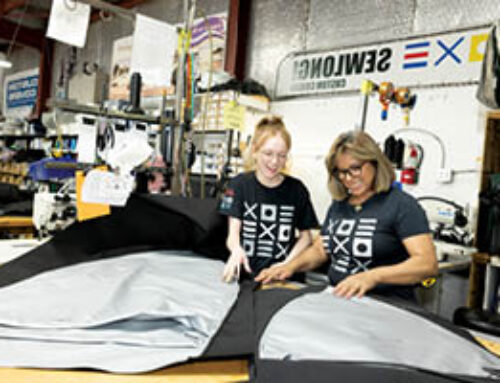Keeping fabric and equipment clean
Industry experts tell their procedures for keeping fabric and equipment clean and functioning properly.
Quality-conscious fabricators demand top-quality components for their end products. Boat owners will insist that fabricators use high-quality, durable materials. The weakest link in any marine product is the quality of the materials that go into making it. With a little investigation to find out what products are best for specific applications, fabricators will receive respect from their customers and all-important repeat business.
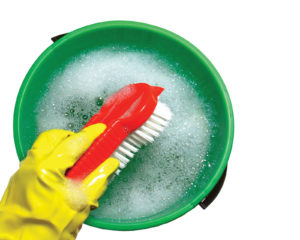 Delivering a high-quality, clean product to a customer is more than a courtesy; it’s a must, especially if you want to keep them as a customer. Regular cleaning and maintenance allow products to function properly. By following a few simple care and maintenance instructions, marine products will maintain beauty and functionality for many years.
Delivering a high-quality, clean product to a customer is more than a courtesy; it’s a must, especially if you want to keep them as a customer. Regular cleaning and maintenance allow products to function properly. By following a few simple care and maintenance instructions, marine products will maintain beauty and functionality for many years.
Easy care engineered into true performance fabrics
When it comes to performance fabrics, the only way to guarantee easy care features for the life of the fabric is through engineering. Starting with substrate selection and continuing through fabric formation and finishing, every element of a true performance fabric is focused on durability, ease of care and low maintenance.
Performance fabrics for boating should contribute to the boat owner’s fun on the water, while enhancing the profitability and success of marine fabricators. When performance fabrics are engineered from the ground up with ease of care and maintenance in mind, both of these goals will be met.
Solution-dyed acrylic fabrics
Derek Robinson, Glen Raven Custom Fabrics LLC
Sunbrella marine fabrics show how carefree characteristics can be engineered into a marine fabric. Starting at the fiber level, color is infused throughout to avoid fading and allows the fabrics to withstand vigorous cleaning, even with chlorine bleach. Fabric formation through weaving assures that Sunbrella marine fabrics are fast drying and breathable, which helps prevent moisture build-up.
Advanced fabric finishes result in most spills remaining on the surface of the fabric where they can be blotted off before staining. Warm water and soap will remove most stains, and solvents can be used for tough stains, such as oil or grease.
Mold and mildew won’t grow directly on the fabric, but these organisms can grow on dirt or other organic matter left on the fabric. Should mold or mildew appear, it can be cleaned with bleach without any damage to the fabric.
Interior fabrics should be occasionally vacuumed or wiped with a damp cloth and spot cleaned as necessary. Exterior fabrics should be hosed with clear water regularly. Both practices will prevent the formation of mold or mildew and assure that superficial stains don’t become embedded and require more vigorous cleaning later.
A few minutes of air drying is usually all that’s necessary. Machine drying with heat is not recommended.
When designing and fabricating cushions or exterior fabric covers, keep in mind that cleaning is greatly simplified if the fabrics can be removed through the use of zippers and snaps. Spreading fabric covers on the dock for cleaning is much easier than cleaning a fabric attached to the boat.
To clean Sunbrella fabrics:
- Brush or vacuum off loose dirt or stains.
- Prepare a mixture of 1/4-cup of mild, natural soap per gallon of water. Recommended soaps: Dreft, Woolite, Ivory Snow.
- Rub using a soft bristle brush.
- Allow soap to soak in.
- Rinse thoroughly.
- Air dry.
If stains persist:
- Prepare a mixture of four ounces (1/2-cup) of chlorine bleach, two ounces (1/4-cup) of natural soap and one gallon of water.
- Clean with soft bristle brush.
- Allow mixture to soak for up to 20 minutes.
- Rinse thoroughly.
- Air dry.
- Repeat if necessary.
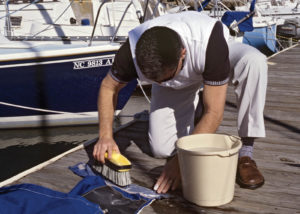 Cushion covers and other applications that can be removed from a boat can be cleaned in a washing machine. Use a natural soap rather than detergent, set for cold water wash and cold water rinse and add bleach if needed. Fabrics should be air dried, and retreatment is recommended.
Cushion covers and other applications that can be removed from a boat can be cleaned in a washing machine. Use a natural soap rather than detergent, set for cold water wash and cold water rinse and add bleach if needed. Fabrics should be air dried, and retreatment is recommended.
When cleaning Sunbrella fabrics, it is important to use a natural soap, never detergent. Water should be cold to lukewarm and not more than 100 degrees. Always air dry the fabrics and retreat after vigorous cleaning.
As part of the original manufacturing process, Sunbrella fabrics are treated with a fluorocarbon finish, which enhances water repellency and stain resistance. This finish lasts several years, but should be replenished after thorough cleaning. 303 High Tech Fabric Guard is the only treatment recommended for Sunbrella fabrics.
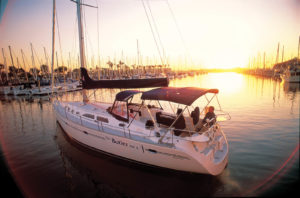
W R9020 WRAY WARD D
In addition to restoring water repellency, the treatment provides protection against oil-based stains. When applying 303 High Tech Fabric Guard:
- Allow fabrics to air dry completely.
- Apply treatment in a thin, even coat.
- After allowing the first coat to dry, apply a second thin, even coating. Two light coatings are more effective in restoring water resistance than a single, heavy coating.
Polyester reinforced PVC fabrics
Craig Zola, Herculite Products Inc.
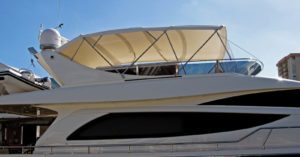 Polyester reinforced PVC fabrics, like Herculite’s Riviera Marine Fabric, are engineered to provide years of satisfactory service. They are waterproof and mildew, stain and dirt resistant. Herculite’s Rain Kleen II surface treatments enhance longevity and ease of maintenance.
Polyester reinforced PVC fabrics, like Herculite’s Riviera Marine Fabric, are engineered to provide years of satisfactory service. They are waterproof and mildew, stain and dirt resistant. Herculite’s Rain Kleen II surface treatments enhance longevity and ease of maintenance.
Polyester reinforced PVC fabrics are dimensionally stable. Properly tailored, they will retain their trim fit and their protective function and aesthetic value. Since no material is impervious to all hazards, proper maintenance is important if maximum life of the product is to be realized.
It’s most important to keep the textile clean. Occasional hosing with clear water prevents dirt accumulation. Most dirt accumulation can be removed with mild soap, water and a soft scrub brush. Rinse thoroughly with clear water. In extreme cases, dirt and mildew can be removed by applying half strength bleach and brushing softly to cover the affected area. Allow the solution to remain for two minutes, then rinse with clear water. Focus on stitching while protecting surrounding materials from the bleach.
In areas conducive to mildew, brush away visible accumulation of dirt on the underside and clean as suggested. Mildew can grow on dirt, but does not grow on or attack Riviera Marine vinyl.
Use care during installation, take down and transporting. Frictional heat, particularly at the folds, can damage the surface and can create holes. Avoid designs that are prone to excessive wind whip or flapping, which can damage the textile over time. When storing, normally fastened sections or panels should be rolled or restrained flat and dry.
Zippers
Paul Lichtenstein, Lenzip Manufacturing Corp.
Like with all mechanical devices, certain procedures should be followed to properly maintain zippers and insure operability and long life. Zippers used in the marine industry demand components that are more stringent than zippers used in a non-marine applications due to the continuous attack of the sun’s UV rays and the rigors of the outdoor environment.
Questions to ask your zipper supplier: Are the resins used to make up the teeth of the zipper UV stable, and are the resins used that make up the teeth of the zipper virgin or regrind resins?
Coil tooth zippers are frequently used on window openings and applications that require a curve, as they can take curves and radii more easily than molded plastic zippers. When comparing cross-wise pull strength between a #10 molded plastic zipper and a #10 coil zipper, coil is approximately 80-percent stronger. This in part is due to the fact that the coil zippers have more locking teeth per inch than molded plastic zippers.
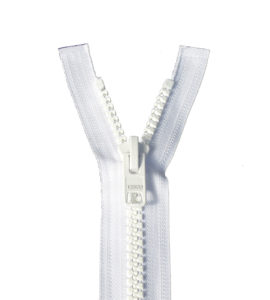
OLYMPUS DIGITAL CAMERA
When sewing in a coil zipper, fabricators can stitch the zipper with the exposed teeth inward toward the cabin of the boat. This method of stitching makes the exterior appearance of the canvas very clean with no zipper teeth exposed, and cuts down on negative effects from UV rays because the zipper teeth are not in direct sunlight.
Zipper care and maintenance is quick and simple, however many boat owners attempt to clean canvas boat tops with cleaning agents or chemicals that may harm the materials used to make the zipper. A top-quality, marine-grade zipper requires little maintenance. The use of proper materials in the manufacturing process assures that only occasional rinsing of the zipper with fresh water will keep the zipper operating properly.
Harsh cleaning chemicals can break down plastic teeth. Zippers made from DuPont’s Delrin resins, like Lenzip zippers, need no lubrication. Other zipper manufacturers suggest that occasional lubrication may enhance the operability of the zipper. Lenzip does not recommend the application of lubricants to its marine zippers.
Fabricators should use zippers, including the teeth and the tape, that are UV resistant. Lenzip guarantees its zippers for life.
Internal and external marine hardware
Frank Wright, DOT Fasteners
Today’s marine grade hardware products, made from non-ferrous based metals, which are used in internal and external applications, require a minimum level of maintenance. Users of the end products that employ the hardware should use common sense in the ongoing upkeep of the hardware.
Common sense recommendations include periodically cleaning all hardware of dirt, any effects of moisture and weather, and any contaminants that may damage the hardware.
Completely dry any product with hardware before storing it, and never store applications in wet or damp conditions. Products used in salt water environments should be rinsed and dried completely prior to storing.
 To get the most trouble-free service from snap fasteners, occasionally spray a dry lubricant into the ring of the socket of the snap fastener assembly. If the ring is frozen and cannot be freed, the socket and cap assembly should be replaced. Continually inspect the condition of the socket and the stud components to insure that there is no damage. If any component is found to be damaged, the attachment should be replaced.
To get the most trouble-free service from snap fasteners, occasionally spray a dry lubricant into the ring of the socket of the snap fastener assembly. If the ring is frozen and cannot be freed, the socket and cap assembly should be replaced. Continually inspect the condition of the socket and the stud components to insure that there is no damage. If any component is found to be damaged, the attachment should be replaced.
As a general rule, any hardware that incorporates a ring, a spring or any moving components should be lubricated periodically. Hardware that does not function as intended should be replaced.
End users of marine products, especially those that are custom made, should insist that the hardware used in the applications incorporate the highest quality materials and workmanship.
Lookalike hardware products may not appear to be cheaper than well-known brands such as DOT, but quality has no price tag when inferior products fail to match the life and performance of quality hardware products.
The ideal source for maintenance tips always is the manufacturer or fabricator of the marine interior or exterior application.
Coated polycarbonate and acrylic window products
Steve Sisco, Ocean Clear Windows
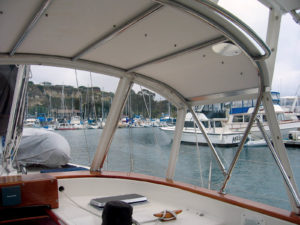 Ocean Clear Makrolon AR is a polycarbonate product. The proprietary UV- and abrasion-resistant surface coating on Makrolon AR significantly improves long-term performance. Periodic cleaning using proper procedures and compatible cleaners is recommended to prolong service life.
Ocean Clear Makrolon AR is a polycarbonate product. The proprietary UV- and abrasion-resistant surface coating on Makrolon AR significantly improves long-term performance. Periodic cleaning using proper procedures and compatible cleaners is recommended to prolong service life.
For general cleaning:
- Wash with a mild solution of soap or detergent and lukewarm water.
- Using a soft cloth or sponge, gently wash the sheet to loosen dirt and grime, and rinse with clean water.
- To prevent water spotting, thoroughly dry with a chamois or cellulose sponge.
- Avoid the use of abrasive cleaners, squeegees and other cleaning implements that may mar or gouge the coating.
- Clean with Mermaid cleaner for a polished finished.
Cleaning agents that have been found to be compatible with Makrolon AR sheet under lab conditions include Formula 409, Top Job, Joy, Palmolive Liquid, Windex D (with Ammonia D), and Mermaid cleaner.
To remove graffiti, paint and marking pen, use Butyl Cellosolve (Hexcel F.O. 554). To remove adhesive from stickers, labels and tape, use VM&P Naphtha (Turco 5042). A hair dryer can be used to heat and soften the adhesive.
Thad Bowes, Rainier Industries
Coated and non-coated window materials require different care. Products like Lexan MR-10 have UV- and scratch-resistant coatings, which don’t scratch as easily as uncoated polycarbonate or acrylic, but can’t be polished in the way acrylic can. Any polishing with buffing wheels or aggressive polishes could undermine the integrity of the coating and decrease life expectancy.
Recommendations for general cleaning of coated polycarbonate: Mermaids Plastic Cleaner, Liquid Joy (non-fragrant) and Top Job. Novus 1 is a cleaner that is designed to shine and decrease fogging, dust and finger prints. It is not a polish. You must reapply Novus 1 on a regular basis as it is water-based and does not contain UV inhibitors. Use only microfiber towels or pure cotton T-shirt material.
Novus 2 and 3 polishes are designed to remove scratches and hazing. They are not recommended for use on coated products such as Lexan MR-10. Abrasive polishes, pads and detergents should not be used on coated products.
Novus 2 has the equivalent scouring power of 1200 grit sandpaper. Novus 3 is equivalent to 600 grit sandpaper. If it is absolutely necessary to polish a coated window, make sure the window is clean, and with a clean cloth, start in a small area, using the least amount of pressure possible.
Acrylic window material can be polished, as there is usually not any protective coating, as least with respect to marine applications. Often, scratches will appear quite early in the window’s life. Recent formulations of modified acrylics designed to be more shatter resistant have left the material less scratch resistant, but buffing works well on this material. Polishes like Novus 2 and 3 will take out minor scratches and blemishes. The material should be clean prior to polishing.
Ask your yacht manager what they use to clean your hard top, as some of the cleaners may affect your windows adversely.
Clear vinyl window products
Edison Irvine, Strataglass
Fabricators should provide their customers with a copy of the care and maintenance information. We recommend using only IMAR Products and mild soap (preferably IMAR Yacht Soap Concentrate) on Strataglass. Never use a wash and wax product or Rainex on Strataglass. Use of cleaners, polishes, scratch removers or any other product made for regular, uncoated vinyl will damage Strataglass and voids the factory warranty.
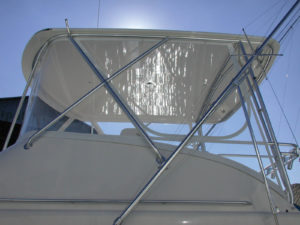 When new, 3M Adhesive Remover may be used to remove glue left from fabrication. Final clean with IMAR Strataglass protective cleaner. We recommend using IMAR Strataglass protective cleaner and protective polish as the final step in installation to provide a base of protection and good watershed.
When new, 3M Adhesive Remover may be used to remove glue left from fabrication. Final clean with IMAR Strataglass protective cleaner. We recommend using IMAR Strataglass protective cleaner and protective polish as the final step in installation to provide a base of protection and good watershed.
For your customers, recommend using IMAR Strataglass protective polish every one to two months. In the interim, the use of IMAR Strataglass protective cleaner is recommended.
To clean, flush thoroughly with water to cool the surface and rinse away environmental abrasives. Wash with IMAR Yacht Soap Concentrate. Apply soapy water to the clear vinyl section of the curtain with a special-purpose washing mitt or soft cotton cloth. Thoroughly rinse the soapy solution with fresh water and completely dry the curtains with a high-quality chamois.
Clear vinyl curtains should be washed whenever the boat is washed. After washing, apply IMAR Strataglass protective polish sparingly with small, light circular motions using a soft cotton cloth. Allow the polish to dry and then remove with a clean soft cotton cloth. Lightly buff to a shine.
For routine maintenance between polishing, use IMAR Strataglass protective cleaner. Insure the clear vinyl panels are free of abrasives. Very lightly mist a soft cotton cloth. Lightly and briskly rub a manageably sized area and then lightly buff dry with another clean cloth.
All new vinyl can easily get impressions in itself. New enclosures should be left in place for as long as possible. If completely removed, enclosures must be interleaved with either acid-free paper or old sheets to prevent “pooling” in the glass. Vinyl “seasons” over time and becomes less impressionable. At night, roll all curtains down and fasten them in place to keep perfect appearance. Do not handle any vinyl with sunscreen on your hands, as it will permanently cloud the vinyl.
We once recommended a restoration process, but experience shows that actual damage cannot be repaired. If IMAR Strataglass protective polish cannot restore the clarity and shine, it may be time to consider replacing the enclosures.
Shop tips
Research and use products yourself so you’ll be able to recommend them to your customers with confidence and offer advice on how to care for their projects. Encouraging regular maintenance will add value to your business and to the services you provide, as well as reducing product warranty issues.
Customers will look to you for guidance and knowledge on what to use and how to clean and protect their investments. All it takes is a little work to maintain good looks and add years of life. That goes for your products, as well as for your customers.
 TEXTILES.ORG
TEXTILES.ORG 


